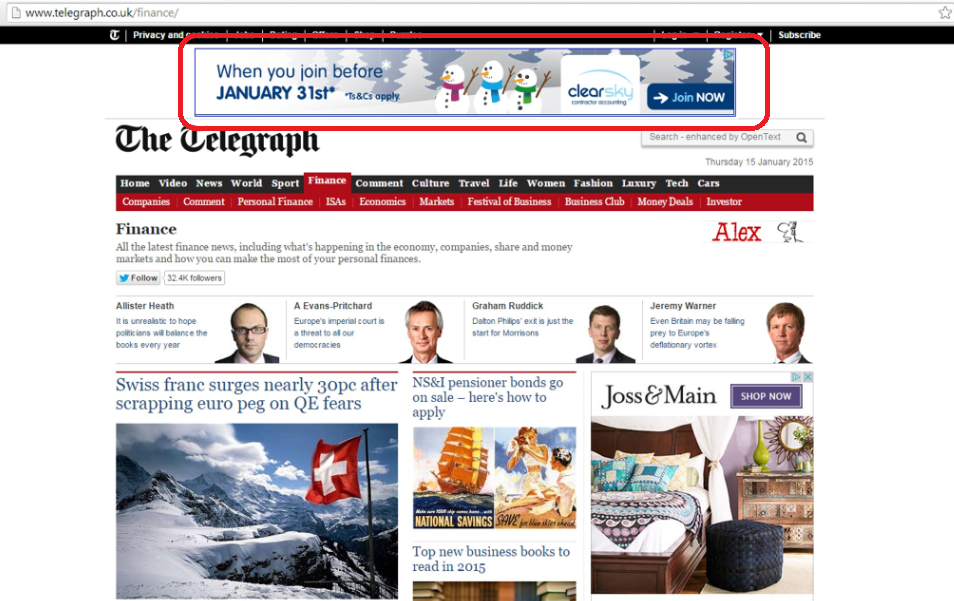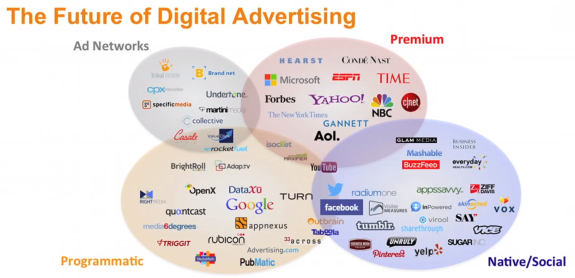Don’t be put off by the intimidating name, if you browse online you will have come across plenty of programmatic ads already. They’re everywhere and if you’ve noticed them they’re doing their job well.

What is Programmatic Advertising?
Programmatic advertising can be defined in a number of ways but, in short, it is the purchasing of online ad space in real time bidding scenarios, then showing your ad to your desired audience via various mediums and across multiple channels.
That means:
- You buy the ad space via an AdExchange
- You are entered in to a bid against your competitors
- Your ad is served IF; you are the highest bidder AND your ad is the most relevant
- Ads can be served across websites, videos, in apps and to your inbox
- Ads shows on desktop, laptop, tablet and mobile
Simply put, programmatic advertising is your above the line media, such as print, TV and radio, but online. This makes measuring your marketing efforts easier than ever.
Before I jump any further in to this here’s a heads up - programmatic is full of abbreviations! Sorry! I know you hate them, but in case you come across some of them in this post (or elsewhere) here they are:
RTB: Real Time Buying
API: Application Program Interface
CDN: Content Delivery Network
DSP: Demand Side Platform
HPB: Human Programmatic Buying
AIB: Artificial Intelligence Buying
ROI: Return on Investment
ROA: Return on Adspend
CPA: Cost per Acquisition
What is an AdExchange?

AdExchanges are companies that own a vast amount of digital real estate. As the digital revolution took hold and people began to build their own blogs, microsites, YouTube channels and websites Ad Networks struggled to sell some of these seemingly worthless plots on. That’s where AdExchanges come in; they buy the landscape in bulk, segment it out according to interest, demographics, content and more and then distribute your ads accordingly.
When will my ad show?
There are two strategies used within programmatic advertising. One is RTB where the AdExchange shows your ad if it the most relevant to the user on that page and your bid is higher than that of your competitors.
There is also something referred to as ‘programmatic direct’ which allows you to buy specific ad impressions in advance from certain publishers.
How does Programmatic Advertising fit in with my other marketing activities?
Programmatic advertising can be broken down in to three targeting strategies.
|
Brand Awareness (Prospecting) |
Direct Response (Prospecting) |
Retargeting |
|
A prospecting campaign involves targeting consumers who have never heard of your brand before or used your services. A branded campaign is used solely to raise brand awareness. Raising brand awareness can have a positive impact on your paid campaign by increasing branded clicks/conversions and lowering your average CPA. Brand awareness campaigns can also help increase your organic rankings, as one of Google’s metrics is brand searches.
|
Direct response campaigns are aimed at attracting new or lapsed users to site with an incentive. An example incentive would be, ‘sign up today for 50% off’. Using direct response display campaigns strategically means you can support your sales team when you know purchasing patterns are low. This type of campaign is also the best choice for introducing a new product or service to market.
|
If you’ve got a user through to your site, whether it’s organically, via paid or display and they haven’t converted that doesn’t mean it’s the end of their journey. Maybe they were carrying out research or waiting for payday? Retargeting allows you to reach out to users who have been on your site but have not yet converted. By using very specific ad creative, remarketing ads have a 10 times higher click-through rate than display and are 70% more likely to convert. |
Programmatic advertising should be used strategically in line with other marketing activities. If you have a radio or TV ad campaign, run a direct response display campaign alongside it to echo the message and encourage users to directly access your site.
If you notice that organic traffic to your homepage is down (traffic to your homepage is often from branded searches) a prospecting brand awareness display campaign can put you back in the mind of your audience.
Advantages of Programmatic Advertising
There are lots of advantages for programmatic advertising but I’m going to list my favourite three:
1: Its multi-channel approach – we’ve all heard the latest buzz words like ‘omnipresent’ marketing. It’s all about being in the right place at the right time, with the right person, and no matter how much we want to avoid buzz words we can’t deny that users are becoming more demanding and much more intelligent. They are jumping from their mobile to their tablet, then their desktop and back again, if you can be in all these places you will be rewarded for it.
2: It’s highly targeted – the various AdExchanges collect masses of information for you so you can target your ideal consumer. They also mine data, track impressions and record the conversions so you can constantly improve your display campaigns. The wealth of information we have on the end user will only continue to grow with technology, pushing channels like display to the forefront of any marketers’ must have methods.
3: Improved ROI – because programmatic advertising is so highly targeted and can utilise various channels it means you get a better return on investment. With tracking tools such as Google Adwords, Google DoubleClick and Google Analytics you can set up attribution models to show how each channel contributes to your customer’s journey and work out a cost effect Return on Adspend.
Disadvantages of Programmatic Advertising
As with all marketing activities there are going to be some disadvantages and programmatic is no different. With display there can be some wastage, your ad can end up on a site that is not overly relevant to the user as the AdExchange inventory is huge and some ads can slip through the net.
However, programmatic ads are managed by humans and wastage can be spotted and minimised within strategic campaign management.
What’s next?
Whether improvements to mobile and native delivery are incoming or the form continues to move into TV ad spaces, there are many possibilities for the next development in programmatic ads.
Programmatic advertising is deservedly being recognised as an essential tool within the marketing mix and segmentation, targeting and positioning will only improve going forward.
Image credit: blog.isocket.com







